WORLD CLASS COACHING
Build Up From the Back - Exercises 2
By Luca Bertolini
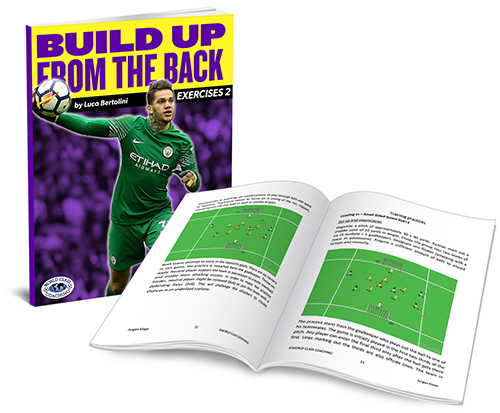
Table of Contents
PART ONE
Introduction
Build Up From GK and Center Backs
PART TWO
Build Up With Center Backs and Midfielders
PART THREE
Small-Sided Games and Exercises
PART FOUR
Build Up with the 4-3-3 and 4-2-3-1
Introduction
"A lot of people said we won in Barcelona because of Messi; they are right. People say we won at Bayern Munich because they always win and they are right too. At City people had doubts that I would be able to win that way, even myself. But we did it. That is why I'm so happy.”
"The idea of what we are going to do is so important. You have to give passes and passes; an extra pass helps you always be together. We run to regain the ball. Not run to run. No pressing just to press. We believe that if we regain the ball high, we are close to score a goal.”
"We let them run, to try in the right moment to attack. Taking the decision in the right moment. That is the most difficult thing in football. What I want is to not lose the ball. Play simple. Do the simple things."
"We play well because we play easily and we play quickly because we play easily.”.."the ball must always moving"
"If you want to dribble to make a 1 v 1 or a feint, let's do it; but if not, move the ball, let's play together and move the opponents.”
"I love attacking because is positive, it makes the players brave and it makes feeling them to have a leading role inside the match.”
Guardiola applied an updated tiki-taka model from Barcelona to Bayern team, as possession was still the king, with the inverted wingers, allowing the fullbacks to provide the width.
A tinkered version of that Bayern blueprint lives on at City. The fullbacks are still vital but they sit a little deeper with Leroy Sané and Raheem Sterling instead providing width.
One of Guardiola's main principles of play has been to build up from the back through the goalkeeper, the center back and the center balance midfielder: Valdes, Pujol, Piquet, and Busquets at Barcelona, Neuer, Dante, Martinez, Kross-Thiago at Bayern; and nowadays with Ederson, Stones, Otamendi, Fernandinho at Manchester City.
Another major feature is playing out from the back through the "fulcrum" of the team--first it was Xavi, Iniesta; then Thiago, Xabi Alonso; now with Kevin De Bruyne, Silva. These players remain the key points.
The reality of City’s title won last season is not the dilution of Guardiola’s ideas but in fact their maximal implementation; the build-up and the play out from the back phases were made efficient and safe.
The technical exercises of the prior volume are to coach the players’ technical skills, the individual tactics and the passing patterns of play to build up and to play out. In those exercises, we focus on breaking the first line of the opposition without active pressure using air-bodies. In this volume we discuss tactical exercises related to real game situations and specific small-sided games.
All the rondos, possession, and position games to work on the players’ tactical skills to build up and play out against active pressure and to coach the reactions to the loss or the recovery of the ball which were included in the prior book, are now useful to coach the individual tactics inside these practices.
All the tactical exercises and the game situations are carried out inside a half or 3/4 of a half field. The half pitch is divided into three parts to locate the players starting positions and the placements while practicing.

All the specific small-sided games are played inside the area of the field where the situation may occur and the dimensions of the pitches are those commonly accepted for the Guardiola's style of positional play.

I relate the tactical exercises to build up from the back to the main systems of play which are coached nowadays: 1-4-2-3-1 and 1-4-3-3.
The defenders must face from 1 to 3 opponents and the midfielders might be in numerical advantage or outnumbered.
Some other tactical practices are dedicated to playing out from the back under strong ultra-offensive opposition pressure. These work on how to manage possession to find a weak area on the field, with and without long balls and how to exploit the space as it's created.
“Tactics determine where the ball should go, but technique determines whether it gets there,” said Johan Cruyff. This is so true when playing out from the back.
As all of us know, the building up phase has become crucial for soccer nowadays. Every coach and every team have their own ways, passing pattern they play, and synchronized movements to play out from the back.
The idea of moving the ball from the goalkeeper and then from the back line could seem to be the contrary of the main objective of soccer, which is to reach the opposite half pitch and to get as close as possible to the opponent's goal. It's easy to think this is a faster and simpler way to attack. For these reasons the most effective strategy to score could seem the long kicks and passes to step over many players, and to approach to the area of danger for the opponents.
But a long ball, like a volleyball of the attacking team, is no longer a ball in possession and it must be recovered.
Knowing this, is it better to play a complex move, building it up from the back or to simplify the sequences with a long kick and then attacking the second times of the ball? The first one seems to be the best solution as the last decade proved.
There is no team without pattern of play and sequences to start the move from the back. The ideas on how to carry them out have become equal to those about set pieces. A good start from the back of the move is the best way to be dangerous inside the opposition goal area.
The beginning of a move is now as important as the finishing phase, the first pass is worth as much as the shot on goal. This multiplies the steps and the movements involved, therefore the chances of a mistake for the team in possession; but it's the same for the defending team.
It also means that the team has to overcome the obstacles all over the field from time to time, without shortcuts; but the advantage is that all the players will arrive to the finishing stage of the move in a better position with a greater inertia and with ideal conditions to easily finish towards the opponent's goal.
As we have already stated, the ideas and the tactics to build up from the back are many and they develop time to time, depending on teams and opponents. Here are some teams' principles of play.
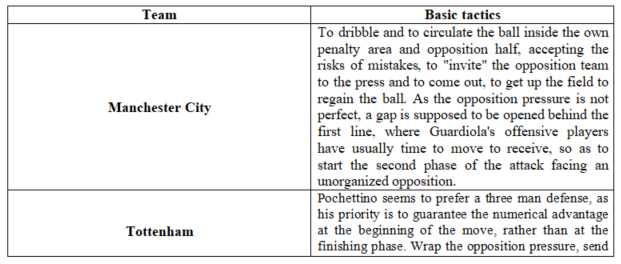
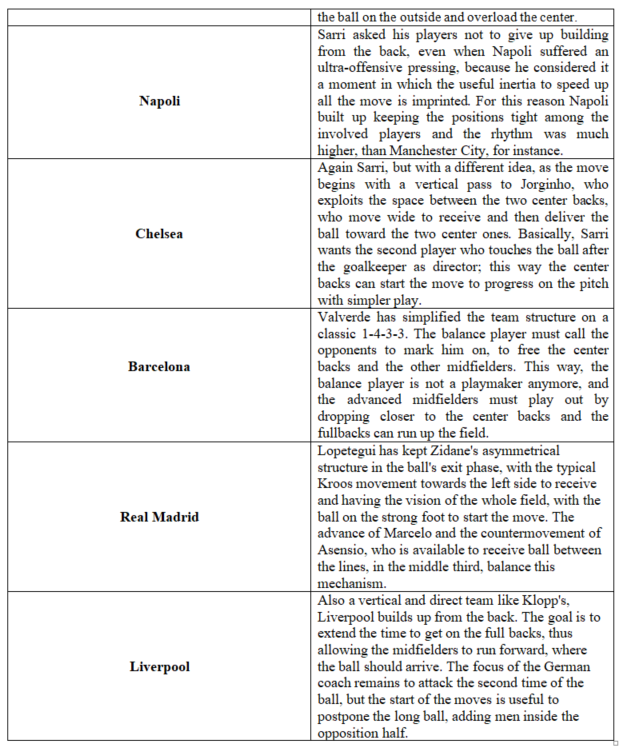
Team requirements to build up and to play out from the back
The main game principles of play to build up from the back are written in "bold" among all the others:
• Play simply and be effective
• Play where you see to play simply
• Keep the ball to move the opposition and to avoid the pressure
• Circulate the ball to create space behind the opposition or to find a passing lane through the first pressure line
• Think and play forward
• Play passes with quality to make the possession safe
• Receive the ball deliberately
• Move cleverly to escape the marker or to find a space to receive
• The third player is the most important
• Have an absolute will to score
• Search 1v1 situations
• Provoke one-twos
• Organize the defense while playing in case of loss of possession
• Press immediately after losing the ball
• Be attacker and defender
• Use surprise effects
• Take risks in the game
• Have fun and enjoy the game
It is important that each player is aware of his objectives (what is expected of him in his position) and how they have to be realized in the context of the:
• team as a whole
• the lines that make up the team
• the individuals who make up the lines
Mobility:
• Mobility of players without the ball
• Constant support of the ball carrier (goalkeeper more than all the other involved teammates
• Triangular passing
• Playing between the lines to progress forward
Key points:
• Communication among the teammates
• Mutual understanding of teammates’ placement and of body position
• Creating Space
• Timing and technique of running to receive with the right body shape
• Timing and technique of passing to play to the right player and in the right space
• Acceleration
• Rhythm
Goalkeeper and center backs combinations
Exercise 1: 2 + gk v 1 (1)

Set-up and Sequence: Place 1 goalkeeper and 2 center backs inside the penalty area against 1 opposition forward. The goalkeeper is in possession, and the goal is to play a 1-2 combination with the first center back, changing the side toward the second center back, to score in one of the mini goals that are placed just out of the penalty area. The second receiver of the first combination must shoot if the sequence must go on.
The opposition forward must try to force the direction of play out of the penalty area, when the center backs are in possession. If he wins the ball, he can finish in the main goal.
Eye on: be placed on different lines and shape a triangle to play diagonal passes with the goalkeeper.
Exercise 2: 2 + gk v 1 (2)
Set-up and Sequence: 1 goalkeeper and 2 center backs are placed inside a penalty area against 1 opposition forward. The goalkeeper is in possession, and the goal is to play quick passing combinations from him to the second center back, changing the side, with one touch pass combination with the first center back to score in one of the mini goals, that are placed just out of the penalty area.
The opposition forward must try to force the direction of play out of the penalty area when the center backs are in possession. If he wins the ball, he can finish in the main goal.
Eye on: be placed on different lines and shape a triangle to play one touch quick diagonal passes to switch the side.
Goalkeeper, center backs and balance midfielder combinations
Exercise 3: 3 + gk v 2

Set-up and Sequence: 1 goalkeeper, 2 center backs and a dropping back midfielder are placed inside a penalty area against 2 opposition forwards. The goalkeeper is in possession, and the goal is to play quick passing combinations from him to the second center backs through the midfielder, changing the side, with one touch pass to score in one of the mini goals that are placed just out of the penalty area.
The opposition forwards must try to force the direction of play out of the penalty area, when the center backs are in possession; or even to press the center midfielder when in possession to face the goal, to finish quickly in case of recovery of the ball.
Eye on: be placed on different lines and shape different triangles to play one-touch quick diagonal passes to switch the side.
Goalkeeper, center backs, balance midfielder and fullbacks combinations
Exercise 4: 5 + gk v 2
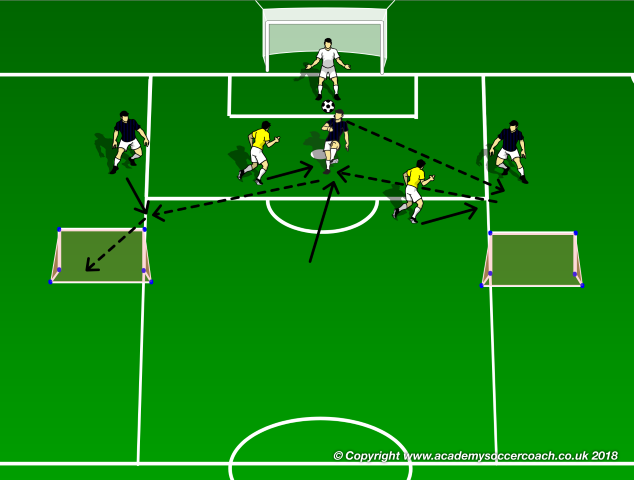
Set-up and Sequence: 1 goalkeeper, 2 center backs, a dropping back midfielder are placed inside a penalty area against 2 opposition forwards. A left and a right fullback are placed wide, facing two mini goals. The goalkeeper is in possession, and the goal is to play quick passing combinations from him to the second center backs, through the midfielder, changing the side and passing the ball toward the opposite fullback, with one touch pass, to score in the mini goal in front of him and close the sideline.
The opposition forwards must try to force the direction of play toward the fullback of the same side when the center backs are in possession; or even to press the center midfielder, when in possession, to face the goal and to finish quickly in case of recovery of the ball.
Eye on: be placed on different lines and shape different triangles to play one-touch quick diagonal passes to switch the side.
Exercise 5: 5 + gk v 4 (2)
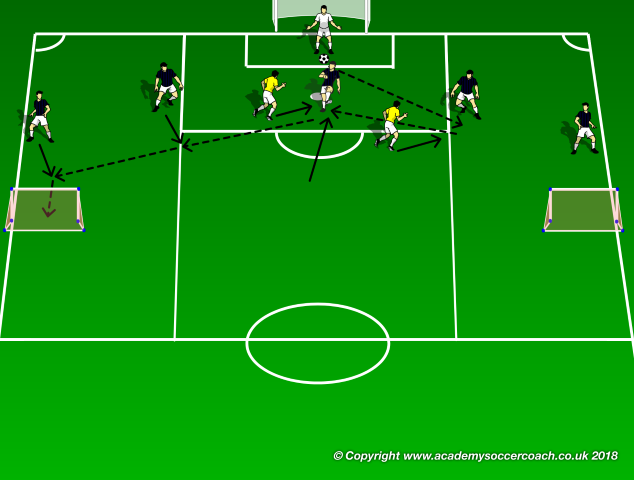
Set-up and Sequence: 1 goalkeeper, 2 center backs, a dropping back midfielder are placed inside a penalty area against 2 opposition forwards. Left and right fullbacks are placed wide, facing two mini goals against 2 opponents.
The goalkeeper is in possession, and the goal is to play quick passing combinations from him to the second center backs through the midfielder, changing the side and passing the ball toward the opposite fullback, with a one touch pass to score in the mini goal in front of him and close the sideline.
The opposition forwards inside the penalty area must try to force the direction of play toward the fullback of the same side, when the center backs are in possession; or even to press the center midfielder, when in possession, to face the goal and to finish quickly in case of recovery of the ball.
The outside yellow forwards must cover the goal space and press the fullback as they receive the ball. If any of the yellow players wins the possession a 4 v 5+gk is created to counter attack.
Variation: 1 yellow player runs inside the penalty area to create a 3+1 v 3 duel inside the penalty area.
Eye on: be placed on different lines and shape different triangles to play one-touch quick diagonal passes to switch the side.
Goalkeeper, center backs, two midfielders and fullbacks combinations
Exercise 6: 6 + gk v 4 (2)
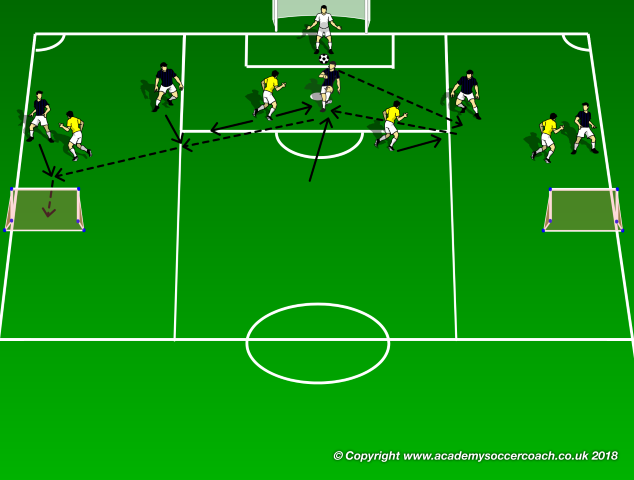
Set-up and Sequence: 1 goalkeeper, 2 center backs, a dropping back midfielder are placed inside a penalty area; 2 opposition forwards are free to move around the center area, where another center midfielder is waiting for the ball to play out and to score in one of the mini goals. Left and right fullbacks are placed wide against 2 opponents.
The goalkeeper is in possession, and the goal is to play quick passing combinations from him to the second center backs through the midfielder, changing the side, and then passing the ball toward the opposite fullback with one touch pass. The final objective is to play out through the center and to give the second center midfielder the chance to score in the mini goals.
The opposition forwards inside the penalty area must try to force the direction of play toward the fullback of the same side, when the center backs are in possession; or even to press the center midfielder, when in possession, to face the goal and to finish quickly in case of recovery of the ball.
The outside yellow forwards must cover the goal space and to press the fullbacks as they receive the ball. If any of the yellow players wins the possession, a 4 v 5+gk is created to counter attack.
Variation: 1 yellow player runs inside the penalty area to create a 3+1 v 3 duel inside the penalty area or one outer yellow player can press inside the center area to prevent the midfielder from scoring.
Eye on: be placed on different lines and shape different triangles to play one-touch quick diagonal passes to switch the side. Break through the first pressure line as quick as possible. Pressure against the ball carrier or close the center passing lanes.
Exercise 7: 6 + gk v 5
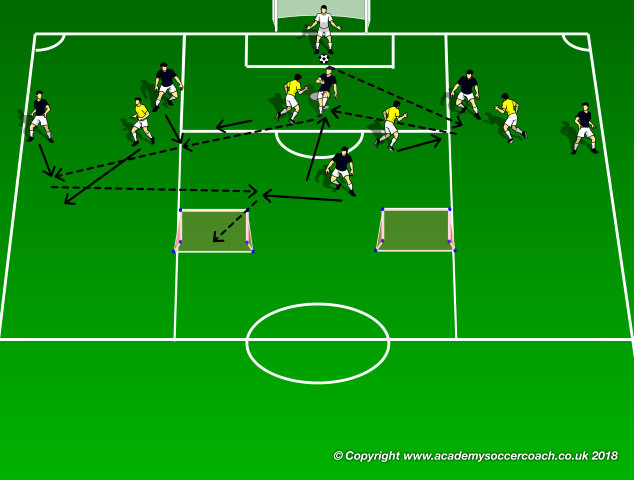
Set-up and Sequence: 1 goalkeeper, 2 center backs, a dropping back midfielder are placed inside a penalty area; 2 opposition forwards are free to move around the center area where another center midfielder is waiting for the ball to play out and to score in one of the mini goals. Left and right fullbacks are placed wide against 2 opponents.
The goalkeeper is in possession, and the goal is to play quick passing combinations from him to the second center back through the midfielder, changing the side, and then passing the ball toward the opposite fullback with one touch pass.
The final objective is to play out through the center and to give the second center midfielder, who is playing a 1 v 1 duel against a yellow player, the chance to score in the mini goals. The opposition forwards inside the penalty area must try to force the direction of play toward the fullback of the same side, when the center backs are in possession; or even to press the center midfielder, when in possession, to face the goal and to finish quickly in case of recovery of the ball.
The outside yellow forwards must cover the goal space and press the fullbacks as they receive the ball. The center yellow player is free to double the mark wherever is needed inside all the other areas. If any of the yellow players wins the possession a 4 v 5+gk is created to counter attack.
Variation: 1 yellow player runs inside the penalty area to create a 3+1 v 3 duel inside the penalty area or one outer yellow player can press inside the center area to prevent the midfielder from scoring.
Eye on: be placed on different lines and shape different triangles to play one-touch quick diagonal passes to switch the side. Break through the first pressure line as quick as possible. Pressure against the ball carrier or close the center passing lanes.
Goalkeeper, center backs, three midfielders and fullbacks combinations
Exercise 8: 7 + gk v 5
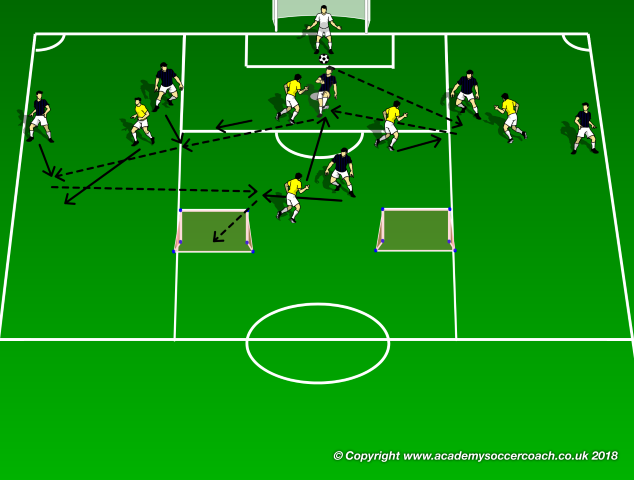
Set-up and Sequence: 1 goalkeeper, 2 center backs, a dropping back midfielder are placed inside a penalty area; 2 opposition forwards and 1 advanced midfielder are free to move around the center area to press the build up phase. Two other center midfielders are waiting for the ball to play out and to score in one of the mini goals that are placed along the flanks, after switching the side. Left and right fullbacks are placed wide against 2 opponents.
The goalkeeper is in possession, and the goal is to play quick passing combinations from him to the second center backs through the midfielder, changing the side for the first time, and then passing the ball toward the opposite fullback with one touch passing combination. The final objective is to play out through the center where a 2 v 1 duel is being carried out, to score in the mini goals along the flanks.
The opposition forwards inside the penalty area must try to force the direction of play toward the fullback of the same side, when the center backs are in possession; or even to press the center midfielders when in possession, to face the goal and to finish quickly in case of recovery of the ball.
The outside yellow forwards must cover the goal space and press the fullbacks as they receive the ball. The center yellow player is free to double the mark wherever is needed inside all the other areas, but his first task should be to close the passing lanes to switch the side. If any of the yellow players wins the possession a 5 v 7+gk is created to counter attack.
Variation: 1 yellow player runs inside the penalty area to create a 3+1 v 3 duel inside the penalty area or one center yellow player can press outside the center area to prevent the fullbacks from scoring.
Eye on: be placed on different lines and shape different triangles to play one-touch quick diagonal passes to switch the side. Break through the first pressure line as quick as possible. Pressure against the ball carrier or close the wide passing lanes.
Exercise 9: 7 + gk v 6
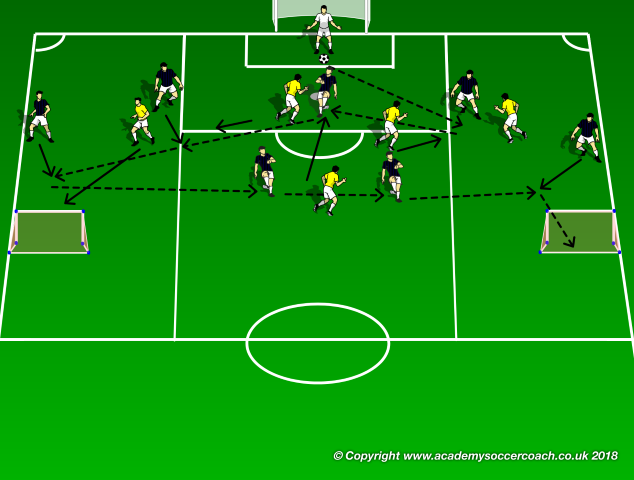
Set-up and Sequence: 1 goalkeeper, 2 center backs, a dropping back midfielder are placed inside a penalty area; 2 opposition forwards and 2 advanced midfielders are free to move around the center area to counter the build up phase. Two other center midfielders are waiting for the ball to play out and to score in one of the mini goals that are placed along the flanks, after switching the side. Left and right fullbacks are placed wide against 2 opposition wingers.
The goalkeeper is in possession, and the goal is to play quick passing combinations from him to the second center back through the midfielder, changing the side for the first time, and then passing the ball toward the opposite fullback, with one touch passing combination. The final objective is to play out through the center, where a 2 v 2 duel is being carried out, to score in the mini goals along the flanks.
The opposition forwards inside the penalty area must try to force the direction of play toward the fullback of the same side when the center backs are in possession; or even to press the center midfielders when in possession, to face the goal and to finish quickly in case of recovery of the ball.
The outside yellow forwards must cover the goal space and press the fullbacks as they receive the ball. The center yellow players are free to double the mark wherever is needed inside all the other areas, but their first task should be to close the passing lanes to switch the side. If any of the yellow players wins the possession a 6 v 7+gk possession game is created to counter attack.
Variation: 1 yellow player runs inside the penalty area to create a 3+1 v 3 duel inside the penalty area or 1 center yellow player can press outside the center area to prevent the fullbacks from scoring.
Eye on: be placed on different lines and shape different triangles to play one-touch quick diagonal passes to switch the side. Break through the first pressure line as quick as possible. Pressure against the ball carrier or close the wide passing lanes.


